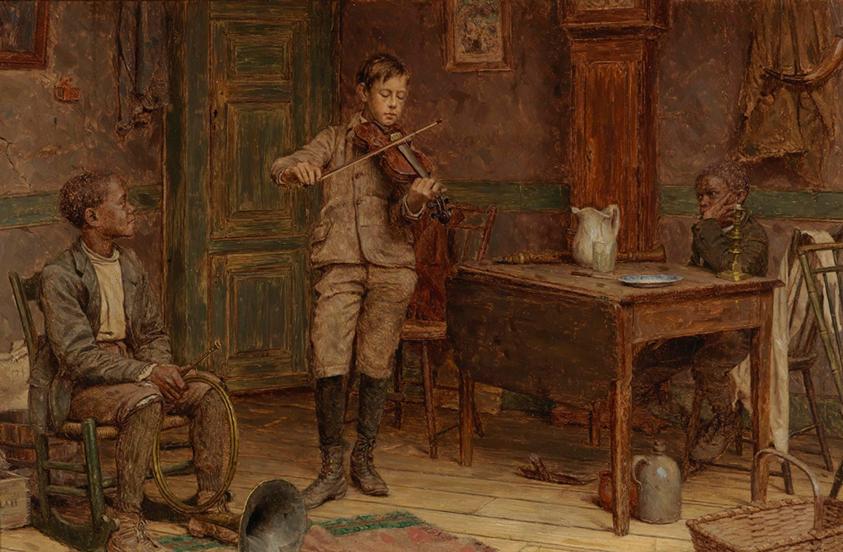
Artist:
Jefferson David Chalfant
(American, 1856 - 1931)
Envious Critics
Medium: Oil on academy board
Date: 1894
Dimensions:
8 1/2 × 12 5/8 in. (21.6 × 32.1 cm)
Accession number: 80.3.4
Label Copy:
While Jefferson David Chalfant is known for his realistic still-life painting, he was also an accomplished figure painter after he spent two years studying in Paris. Upon his return, he settled in Wilmington, Delaware, and concentrated on genre paintings—depicting scenes of everyday life—such as Envious Critics. This trio of young musicians likely began as models posed in Chalfant’s studio and photographed as the first step in the artist’s creative process. Chalfant then made drawings from the photographs, which eventually led to the finished painting.
Curatorial RemarksWilmington, Delaware, artist Jefferson David Chalfant began his career as a still-life painter, then turned to other subject matter when public interest in still life declined. In 1890 he studied at the Academie Julian in Paris. Upon his return, he concentrated on anecdotal scenes of everyday life (genre subjects), such as may be seen in "Envious Critics." His painting style is extraordinarily precise, reflecting his "trompe l'oeil" technique.
Chalfant posed models in prop-filled studio settings. He then photographed the posed scenes, from which he made drawings in preparation for the final painting. He used the same models many times for different paintings of similar content.
Wilmington, Delaware, artist Jefferson David Chalfant began his career as a still-life painter, then turned to other subject matter when public interest in still life declined. In 1890 he studied at the Academie Julian in Paris. Upon his return, he concentrated on anecdotal scenes of everyday life (genre subjects), such as may be seen in Envious Critics. His painting style is extraordinarily precise, reflecting his training in trompe l'oeil techniques.
Chalfant posed models in prop-filled studio settings. He then photographed the posed scenes, from which he made drawings in preparation for the final painting. He used the same models many times for different paintings of similar content.
Chalfant posed models in prop-filled studio settings. He then photographed the posed scenes, from which he made drawings in preparation for the final painting. He used the same models many times for different paintings of similar content.
Wilmington, Delaware, artist Jefferson David Chalfant began his career as a still-life painter, then turned to other subject matter when public interest in still life declined. In 1890 he studied at the Academie Julian in Paris. Upon his return, he concentrated on anecdotal scenes of everyday life (genre subjects), such as may be seen in Envious Critics. His painting style is extraordinarily precise, reflecting his training in trompe l'oeil techniques.
Chalfant posed models in prop-filled studio settings. He then photographed the posed scenes, from which he made drawings in preparation for the final painting. He used the same models many times for different paintings of similar content.